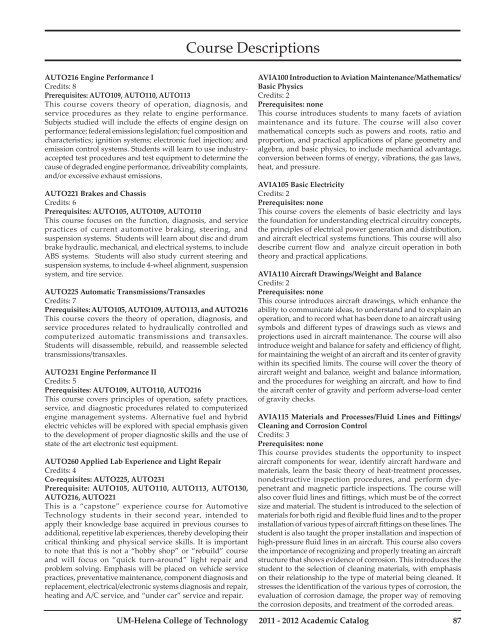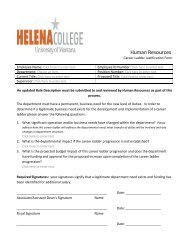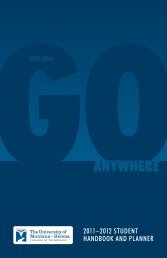2011 - 2012 Student Calendar - Helena College of Technology
2011 - 2012 Student Calendar - Helena College of Technology
2011 - 2012 Student Calendar - Helena College of Technology
- No tags were found...
Create successful ePaper yourself
Turn your PDF publications into a flip-book with our unique Google optimized e-Paper software.
Course DescriptionsAUTO216 Engine Performance ICredits: 8Prerequisites: AUTO109, AUTO110, AUTO113This course covers theory <strong>of</strong> operation, diagnosis, andservice procedures as they relate to engine performance.Subjects studied will include the effects <strong>of</strong> engine design onperformance; federal emissions legislation; fuel composition andcharacteristics; ignition systems; electronic fuel injection; andemission control systems. <strong>Student</strong>s will learn to use industryacceptedtest procedures and test equipment to determine thecause <strong>of</strong> degraded engine performance, driveability complaints,and/or excessive exhaust emissions.AUTO221 Brakes and ChassisCredits: 6Prerequisites: AUTO105, AUTO109, AUTO110This course focuses on the function, diagnosis, and servicepractices <strong>of</strong> current automotive braking, steering, andsuspension systems. <strong>Student</strong>s will learn about disc and drumbrake hydraulic, mechanical, and electrical systems, to includeABS systems. <strong>Student</strong>s will also study current steering andsuspension systems, to include 4-wheel alignment, suspensionsystem, and tire service.AUTO225 Automatic Transmissions/TransaxlesCredits: 7Prerequisites: AUTO105, AUTO109, AUTO113, and AUTO216This course covers the theory <strong>of</strong> operation, diagnosis, andservice procedures related to hydraulically controlled andcomputerized automatic transmissions and transaxles.<strong>Student</strong>s will disassemble, rebuild, and reassemble selectedtransmissions/transaxles.AUTO231 Engine Performance IICredits: 5Prerequisites: AUTO109, AUTO110, AUTO216This course covers principles <strong>of</strong> operation, safety practices,service, and diagnostic procedures related to computerizedengine management systems. Alternative fuel and hybridelectric vehicles will be explored with special emphasis givento the development <strong>of</strong> proper diagnostic skills and the use <strong>of</strong>state <strong>of</strong> the art electronic test equipment.AUTO260 Applied Lab Experience and Light RepairCredits: 4Co-requisites: AUTO225, AUTO231Prerequisite: AUTO105, AUTO110, AUTO113, AUTO130,AUTO216, AUTO221This is a “capstone” experience course for Automotive<strong>Technology</strong> students in their second year, intended toapply their knowledge base acquired in previous courses toadditional, repetitive lab experiences, thereby developing theircritical thinking and physical service skills. It is importantto note that this is not a “hobby shop” or “rebuild” courseand will focus on “quick turn-around” light repair andproblem solving. Emphasis will be placed on vehicle servicepractices, preventative maintenance, component diagnosis andreplacement, electrical/electronic systems diagnosis and repair,heating and A/C service, and “under car” service and repair.AVIA100 Introduction to Aviation Maintenance/Mathematics/Basic PhysicsCredits: 2Prerequisites: noneThis course introduces students to many facets <strong>of</strong> aviationmaintenance and its future. The course will also covermathematical concepts such as powers and roots, ratio andproportion, and practical applications <strong>of</strong> plane geometry andalgebra, and basic physics, to include mechanical advantage,conversion between forms <strong>of</strong> energy, vibrations, the gas laws,heat, and pressure.AVIA105 Basic ElectricityCredits: 2Prerequisites: noneThis course covers the elements <strong>of</strong> basic electricity and laysthe foundation for understanding electrical circuitry concepts,the principles <strong>of</strong> electrical power generation and distribution,and aircraft electrical systems functions. This course will alsodescribe current flow and analyze circuit operation in boththeory and practical applications.AVIA110 Aircraft Drawings/Weight and BalanceCredits: 2Prerequisites: noneThis course introduces aircraft drawings, which enhance theability to communicate ideas, to understand and to explain anoperation, and to record what has been done to an aircraft usingsymbols and different types <strong>of</strong> drawings such as views andprojections used in aircraft maintenance. The course will alsointroduce weight and balance for safety and efficiency <strong>of</strong> flight,for maintaining the weight <strong>of</strong> an aircraft and its center <strong>of</strong> gravitywithin its specified limits. The course will cover the theory <strong>of</strong>aircraft weight and balance, weight and balance information,and the procedures for weighing an aircraft, and how to findthe aircraft center <strong>of</strong> gravity and perform adverse-load center<strong>of</strong> gravity checks.AVIA115 Materials and Processes/Fluid Lines and Fittings/Cleaning and Corrosion ControlCredits: 3Prerequisites: noneThis course provides students the opportunity to inspectaircraft components for wear, identify aircraft hardware andmaterials, learn the basic theory <strong>of</strong> heat-treatment processes,nondestructive inspection procedures, and perform dyepenetrantand magnetic particle inspections. The course willalso cover fluid lines and fittings, which must be <strong>of</strong> the correctsize and material. The student is introduced to the selection <strong>of</strong>materials for both rigid and flexible fluid lines and to the properinstallation <strong>of</strong> various types <strong>of</strong> aircraft fittings on these lines. Thestudent is also taught the proper installation and inspection <strong>of</strong>high-pressure fluid lines in an aircraft. This course also coversthe importance <strong>of</strong> recognizing and properly treating an aircraftstructure that shows evidence <strong>of</strong> corrosion. This introduces thestudent to the selection <strong>of</strong> cleaning materials, with emphasison their relationship to the type <strong>of</strong> material being cleaned. Itstresses the identification <strong>of</strong> the various types <strong>of</strong> corrosion, theevaluation <strong>of</strong> corrosion damage, the proper way <strong>of</strong> removingthe corrosion deposits, and treatment <strong>of</strong> the corroded areas.UM-<strong>Helena</strong> <strong>College</strong> <strong>of</strong> <strong>Technology</strong> <strong>2011</strong> - <strong>2012</strong> Academic Catalog 87




